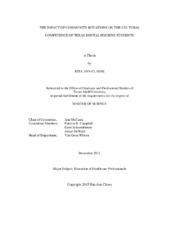| dc.description.abstract | A rise in oral health disparities among ethnic minority groups calls for dental professionals to be culturally competent. This study investigated the role of community rotations on the cultural competence of second-year dental hygiene students. Program directors were emailed a preliminary inventory to collect their student demographics and programmatic information regarding community rotations. An adapted paper version of the validated Clinical Cultural Competency Questionnaire (CCCQ) that self-assesses cultural competence was given to students at twelve Texas dental hygiene programs with a response rate of 100% (239/239). Data analysis was performed using the Kendall tau correlation for associations and the Kruskal-Wallis and Mann-Whitney U tests for differences among and between groups. Students scored in the 60-65th percentile in knowledge, skill, and comfort and in the 86th percentile for attitude. This study found that the amount of time spent in community rotations (p=0.009), number of community rotations (p=0.028), ethnic diversity of patients in program clinics (p=0.042), and cultural competence training hours (p=0.044) were associated with increased cultural competence scores in Texas dental hygiene students. Those participating in over 50 hours of community rotations (p=0.006) scored significantly higher than students with less than 50 hours. Generally, those with four rotations (p=0.002) scored higher than students with other numbers of rotations. Those with public clinic (p=0.049) and school (p=0.044) rotations scored significantly higher than those without these rotation experiences. Those with experience in nursing homes (p=0.009) and hospitals (p=0.026) scored lower than those without experience in these rotations. Students seeing the most ethnically diverse patients in program clinics scored higher (p=0.014) than students who saw a less diverse pool of patients. Those with 6-10 training hours scored higher (p=0.013) than those with fewer than 6 hours or more than 10 hours of training. All ethnic minorities, excluding Asians, scored higher than Whites (p=0.008, p=0.020). Based on these results, it is recommended that dental hygiene programs invest significant time in cultural competence training and carefully choose a robust program of community rotations. Furthermore, efforts to improve the diversity of the faculty, student body and clinic patient pool may enhance the cultural competence of graduates. | en |


